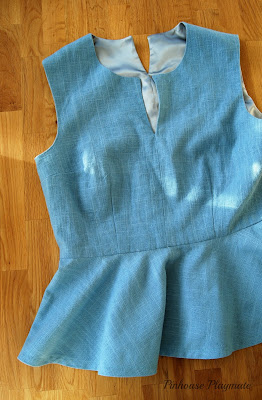A rather nice top with a peplum and key hole cutouts front and back. I remember reading somewhere that peplums are flattering to the slightly uncurvy figure (of which I have plenty), and I suspect that's why I bought it in the first place.
I've made kind of a silent pledge to use patterns, and when possible, fabrics that are already in my stash. Just to keep costs down, and also keep the hoard down (and make room for new fabric, of course). I am happy to report that nothing new was purchased for this project, and it all started with the top.
I initially meant for this to be just a muslin of the Salme peplum top. I found two pieces of light blue linen in my stash that I bought out of a remnant bin. The weave is quite loose, and the fabric is a medium weight, but very soft. I really liked the colour, so if all turned out well, I could see myself wearing it. In some happy twist of events, I also found a piece of silvery grey acetate lining, and a plan started forming in my mind.
The top sewed up great. The instructions were very good, much better than for the playsuit luckily. But it was hard to check the top for fit during construction. You need to sew the lining to the bodice early in the process, and you won't be able to really try it on until the zipper is in. And for that to happen, you need to attach the peplum piece too, as the zipper is in the side seam, and halfway down the peplum.
The top was a good fit over the shoulders and bust, but baggy below the bust. So, I had to take it apart again to make adjustments. The main issues were the bust darts (and the bodice length). I had fabric pooling on each side under the bust. I noticed that the dart needed to be taken in in the lower half only, so the excess would be taken up in the dart. It did wonders for the bagginess. I also took in a little bit more in the back darts, to tighten it up a bit.
The fabric caused a bit of a problem, because it "grows" when handled and ironed too much. I made some wide legged trousers out of the same quality, and that has now got "knee-bags" in it. And a saggy butt. The top really needs lining, but during all the adjusting and unpicking, it had no support and it was hard not to stretch it. It would have benefited to be underlined, but I didn't want it to be too heavy. It was alright, as long as it was handled with care. (Top tip (and note to self!); when dealing with fabric that wants to warp and stretch, it helps to press, not iron.)
I noticed that with a peplum it is very important that the waist seam sits exactly at the natural waist, or the bodice will bunch up if it is too long. I attached my peplum twice before I found the sweet spot, and I also learnt that I'm rather short waisted! Fitting clothing is quite enlightening, and I think it is very interesting to see the huge differences small adjustments make.
Now, there is one thing I didn't like about the pattern, the peplum piece is not lined. This peplum is basically a very short full circle skirt, and we all know what it's like to hem a full circle. If the pieces were lined, you would have a clean finish on the (whole) inside, plus have the hemming sorted in one swoop. I didn't have enough lining fabric anyway, but If I make this top again the peplum will be lined.
 |
| I hemmed the peplum with bias binding, and did the same for the skirt. |
 |
| The cutout in the bodice is supposed to be closed by a stitch in the corner. But I like it open, because you can flip down the tips, and have a collar of sorts. We'll see what I end up doing |
 |
| A little press and some minor finishing left! |
When the top was all done, I still had a decent piece of linen left. Was it enough for a skirt? Why, yes it was! The thought of a whole linen outfit was tantalising!
The pattern is part of McCalls #7608 from the 1960s, a suit with a blouse. I decided to use the straight skirt, as it matched my waist size, so hopefully not too much redrafting. It also features a kick pleat in the back. (I also MUST make the jacket from this pattern, it looks great!)
Sadly, there was not enough of the silvery lining left, but I knew the skirt absolutely had to have support, so I went with underlining. You basically cut your skirt pieces in fashion fabric and another lining fabric, baste the edges together and treat them as one piece for the rest of the construction. The seam allowances need to be finished with this technique, and I went for binding them with bias strips of leftover acetate lining. The underlining is very fine cotton batiste, densely woven and ultra light.
When I stitched it up and tried it on it was very frumpy. Comfortable, yes, but oh so frumpy! I shaved off about one inch on both hips, and lightly pegged the skirt, so that it tapers in towards the hem. In all, I narrowed it 8" on the total width, so quite a lot!
There's only some handstitching to do on the skirt hem, and top lining. I also need to attach a hook and eye closure for the skirt and finish the zipper end. But other than that, I am just waiting for the sun to shine, so I can get pictures for the "big reveal"!































